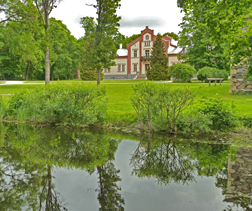 Off the Estonian coast in the Baltic Sea lies a pastoral island called Muhu. Reached by a half-hour ferry from the mainland, it’s extremely rural, with only a couple of tiny villages and the rest farms, fields full of russet cattle and round hay bales and forest. On the southern shore lies Pädaste Manor, an ancient estate and manor house that in recent years has been turned into a tranquil resort. After the four-hour drive from our first Baltic stop in Riga, Latvia, we arrived at Pädaste early one blustery afternoon for a two-day rural interlude in our itinerary of city centers.
Off the Estonian coast in the Baltic Sea lies a pastoral island called Muhu. Reached by a half-hour ferry from the mainland, it’s extremely rural, with only a couple of tiny villages and the rest farms, fields full of russet cattle and round hay bales and forest. On the southern shore lies Pädaste Manor, an ancient estate and manor house that in recent years has been turned into a tranquil resort. After the four-hour drive from our first Baltic stop in Riga, Latvia, we arrived at Pädaste early one blustery afternoon for a two-day rural interlude in our itinerary of city centers.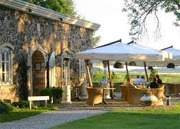 After settling into our spacious room on the second floor, we took a half-hour walk around the estate, and arrived at what the owners dub the Sea House – a stone building with flagged terraces that fronts the marshes of the Baltic sea-front, and serves in summer as the estate’s lunch restaurant. Too cold and blustery to sit outside, we made ourselves comfortable in the cozy stone and wood-paneled dining room. Both the Sea House and the main restaurant in the manor house are overseen
After settling into our spacious room on the second floor, we took a half-hour walk around the estate, and arrived at what the owners dub the Sea House – a stone building with flagged terraces that fronts the marshes of the Baltic sea-front, and serves in summer as the estate’s lunch restaurant. Too cold and blustery to sit outside, we made ourselves comfortable in the cozy stone and wood-paneled dining room. Both the Sea House and the main restaurant in the manor house are overseen by chef Peeter Pihel, who produces what he refers to as Nordic Islands Cuisine. The lunch menu is dotted with fascinating and unusual combinations.
by chef Peeter Pihel, who produces what he refers to as Nordic Islands Cuisine. The lunch menu is dotted with fascinating and unusual combinations. We couldn’t resist an order of the Manor Bread Sticks to start – a dense rye bread studded with raisins, dried cherries and hazelnuts, cut into square sticks fried in butter and served with fresh horseradish sauce for dipping. Absolutely irresistible. Next, one of us chose the fresh goat cheese & vegetable salad--the creamiest, goatiest cheese ever, mixed with blanched carrots, radishes, shaved raw beets, onions and baby greens. Another elected the Matje herring plate: warm salted herring, dilled cucumber, tiny potatoes, perfect crispy poached eggs and a fresh cottage cheese—a combination we’d never think of, but that’s quite delicious. I selected the summer vegetable stew—a
We couldn’t resist an order of the Manor Bread Sticks to start – a dense rye bread studded with raisins, dried cherries and hazelnuts, cut into square sticks fried in butter and served with fresh horseradish sauce for dipping. Absolutely irresistible. Next, one of us chose the fresh goat cheese & vegetable salad--the creamiest, goatiest cheese ever, mixed with blanched carrots, radishes, shaved raw beets, onions and baby greens. Another elected the Matje herring plate: warm salted herring, dilled cucumber, tiny potatoes, perfect crispy poached eggs and a fresh cottage cheese—a combination we’d never think of, but that’s quite delicious. I selected the summer vegetable stew—a 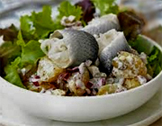 soup-plate of just-done newly-dug potatoes, baby carrots, turnips, snap peas, sugar peas and cabbage in a rich meaty broth both light and deeply flavored at the same time. I caught chef Pihel for a few minutes the next morning while he was prepping veal in the Sea House kitchen, and asked him about Nordic Islands Cuisine. He said, “it’s about the freshest foods of the local islands--Muhu as well as Gotland, Bornholm and other, and old style cooking techniques. We gather and forage daily, and do a lot of
soup-plate of just-done newly-dug potatoes, baby carrots, turnips, snap peas, sugar peas and cabbage in a rich meaty broth both light and deeply flavored at the same time. I caught chef Pihel for a few minutes the next morning while he was prepping veal in the Sea House kitchen, and asked him about Nordic Islands Cuisine. He said, “it’s about the freshest foods of the local islands--Muhu as well as Gotland, Bornholm and other, and old style cooking techniques. We gather and forage daily, and do a lot of 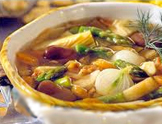 smoking, drying, pickling and salting. No molecular gastronomy here.”
smoking, drying, pickling and salting. No molecular gastronomy here.”
We walked to the seaside after lunch – a bit of a misnomer – a path through the grasses and marshes to the point where the water comes up in the marsh; there’s no beach, sandy or rocky. A channel has been cut back into the property with a deck and lounge chairs at its end for seaside relaxing, and even a ladder up which to climb after a bracing dip in the salt water. Near the water’s edge is a wooden-tank, log-fired hot-tub that guests can reserve for their personal use in the light northern nights, pursuing the Nordic custom of hot dip, cold plunge, then do it all again. 
The origins of the estate go back as far as the 14th century, and the current manor dates to the late 1900’s. In the winter of 1919 then-current owner Baron Axel von Buxhoeveden was assassinated by revolutionaries while on his way from Pädaste Manor to the mainland. Years of neglect followed during the Soviet period in which the use of the manor alternated between army headquarter, fish distribution center and home for the elderly, until its abandonment in the early 80’s.
Then in 1996 Martin Breuer and Imre Sooäär acquired the manor and over several years began to restore Pädaste to new splendor, with the goal of creating one of the finest small luxury hotels in the Baltic countryside. I caught Martin one morning, and he told me “the Manor is a labor of love, and an ongoing project – we may never be finished, but we’re very happy with what we’ve done.” For activities, Pädaste offers fishing, horseback riding, guided nature walks, boat and bike rental and a variety of spa treatments, including mud wraps, hay baths and a log-cabin sauna. We were interested in a quiet interlude, and our two days were spent strolling the grounds, walking in the forest, reading and relaxing. And of course, eating.
For activities, Pädaste offers fishing, horseback riding, guided nature walks, boat and bike rental and a variety of spa treatments, including mud wraps, hay baths and a log-cabin sauna. We were interested in a quiet interlude, and our two days were spent strolling the grounds, walking in the forest, reading and relaxing. And of course, eating.
A great glass conservatory off the main dining room was added during the renovations, and summer dining takes place there in Alexander Restaurant. (For three months of the winter, Pädaste closes, and the entire restaurant moves to Tallinn to be reincarnated as Restaurant Neh).
Chef Pihel said that Alexander features an elegant version of the Nordic Islands Cuisine, contrasted to the Sea House’s more rustic offerings. The menu is prix fixe with three to five courses, diner’s choice. None of us ordered all five, but between us, we sampled everything. 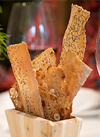
Out of the chute was an absolutely ethereal boudin blanc paired with braised cabbage in a rich veal broth. Next up--butter poached cod in beurre blanc, served with a potato puree’ that would make Robuchon nod in approval.
As a palate cleanser we were served a black currant gelée with fresh yoghurt & sea buckthorn granita. Sea buckthorn is a tart golden berry much used in Nordic and Scandinavian cuisine.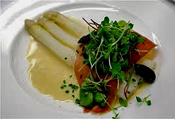 All Europe is crazy for white asparagus, and perfect white stalks napped in sauce hollandaise were paired with duck prosciutto and mache in warm lingonberry vinaigrette. One of our party is quite keen for quail, and chef Pihel’s presentation is a boned quail turned inside out with legs somehow sticking out—I’m not quite sure about the geometry. The meat was perfectly moist and crispy-skinned, served on a fruit-enhanced glace de viande with apple/celery puree and sauteed greens.
All Europe is crazy for white asparagus, and perfect white stalks napped in sauce hollandaise were paired with duck prosciutto and mache in warm lingonberry vinaigrette. One of our party is quite keen for quail, and chef Pihel’s presentation is a boned quail turned inside out with legs somehow sticking out—I’m not quite sure about the geometry. The meat was perfectly moist and crispy-skinned, served on a fruit-enhanced glace de viande with apple/celery puree and sauteed greens. 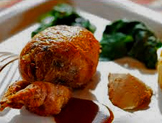
Lastly came Muhu Island and Gotland cheeses: an intense, very aged cow’s-milk blue, a concentrated & salty goat, and a creamy cheddar-like cow’s-milk cheese, served with cloudberry jam, apple-wine syrup and cumin bread crisps.
A non-Nordic glass of grappa later, we prepared to retire, satiated and full of wonder at the gastronomic excellence of this remote and relaxing spot.